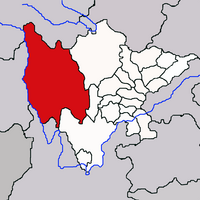Sichuan-Tibet Networking Project
The Sichuan-Tibet Networking Project (Chinese: 川藏联网工程), or Sichuan-Tibet Interconnection Project, formally referred to as the Sichuan-Tibet Interconnection Transmission and Transformation Project, HVDC Sichuan-Tibet, seeks to link the power grid of Chamdo in Tibet with that of Sichuan, thereby terminating the prolonged isolation of the Chamdo region and fundamentally addressing the critical electricity shortage and power deficiency in the southern areas of Chamdo and Garzê in Sichuan.[1][2] The project spans over 1,500 kilometers, predominantly situated in high mountainous and uninhabited regions, with an average elevation of 3,850 meters and a maximum elevation of 4,980 meters, considered the most arduous power transmission endeavor in the world.[3][4]
Geography
[edit]In the southern region of Garzê Prefecture in Sichuan and the Chamdo area in Tibet, where the average elevation exceeds 3,500 meters, over 700,000 farmers and herdsmen lack reliable access to electricity.[5] The Sichuan-Tibet Interconnection Project links the Tibet-Changdu power grid with the Sichuan power grid, situated on the "Three Rivers Nature Reserve" fault zone where the Jinsha, Nu, and Lancang Rivers converge, recognized as one of the most intricate geological formations and a region with extensive geologic hazards in the world.[6] The project spans over 1,500 kilometers, predominantly traversing high mountains and uninhabited terrain, with an average altitude of 3,850 meters and a maximum altitude of 4,980 meters. [7]
Project History
[edit]In August 2013, the State Grid Corporation established the Sichuan-Tibet Interconnection Project Construction Command and stationed it in Batang to comprehensively execute the construction preparatory activities.[8] In January 2014, the National Development and Reform Commission approved the engineering feasibility study program.[9] The project encompasses 1009.2 kilometers of new 500kV transmission line from Xiangcheng to Batang to Chamdo, 512 kilometers of new 220kV transmission line from Chamdo to Yulong and from Chamdo to Batang County, along with the construction of two new 500kV substations in Batang and Chamdo, and two 220kV substations in Bangda and Yulong.[10] The project's overall investment amounts to 6.63 billion yuan.[11][12]
The Sichuan-Tibet connectivity project commenced on March 18, 2014. This is another significant electricity transmission and transformation initiative that crosses alpine and high-altitude regions following the Qinghai-Tibet Networking Project.[13][14] On August 4, 2014, the Sichuan-Tibet Networking Project commenced wire erection, successfully across the Jinsha River five times, and on November 20, the commissioning ceremony for the Sichuan-Tibet Power Networking Project took place. Yu Zhengsheng, a member of the Politburo Standing Committee of the Chinese Communist Party and Chairman of the National Committee of the Chinese People's Political Consultative Conference (CPPCC), attended the ceremony in Beijing and declared the project's commencement of operations.[15][16][16]
The Sichuan-Tibet Power Interconnection Project terminated the prolonged history of isolated network operation in the Chamdo region of Tibet and fundamentally address the power consumption issues of almost 500,000 residents in the area.[17]
See also
[edit]References
[edit]- ^ "川藏联网让145万人告别用电难-债劵-广发银行". 广发银行 (in Chinese). 2014-11-24. Retrieved 2024-10-06.
- ^ “治国必治边、治边先稳藏”重要战略思想研究 (in Chinese). 社会科学文献出版社. 2016. p. 59. ISBN 978-7-5097-9848-5. Retrieved 2024-10-06.
- ^ 电力史话 (in Chinese). 社会科学文献出版社. 2015. p. 167. ISBN 978-7-5097-7596-7. Retrieved 2024-10-06.
- ^ "Construction begins Sichuan-Tibet power grid". chinadaily.com.cn (in Slovenian). Retrieved 2024-10-06.
- ^ ""电"亮藏区——四川电网"新甘石"联网工程建设纪实---国家能源局". 国家能源局 (in Chinese). 2011-10-26. Retrieved 2024-10-06.
- ^ "川藏电力联网主体工程完工". 甘孜藏族自治州人民政府网站. 2014-09-23. Retrieved 2024-10-06.
- ^ "川藏电力联网工程20日正式投运". 新华网_让新闻离你更近 (in Chinese). Retrieved 2024-10-06.
- ^ "低温、严寒、高海拔!四条"电力天路"助力西藏脱贫攻坚_新闻_央视网(cctv.com)". cctv.com (in Chinese). 2019-12-31. Retrieved 2024-10-06.
- ^ "川藏电力联网工程正式投运-光明日报-光明网". 光明数字报 (in Chinese). 2014-11-21. Retrieved 2024-10-06.
- ^ "全球最具挑战性输变电工程 川藏联网工程开工". energy.people.com.cn (in Chinese). 2014-03-31. Retrieved 2024-10-06.
- ^ "川藏电力联网工程正式投运_图片_新闻_中国政府网". 中国政府网_中央人民政府门户网站 (in Chinese). 2014-11-20. Retrieved 2024-10-06.
- ^ "川藏联网工程年底建成投运 五跨金沙江投资66亿". 中国新闻网_梳理天下新闻 (in Chinese). 2014-08-11. Retrieved 2024-10-06.
- ^ "川藏联网工程开工建设 西藏再添"电力天路"_中华人民共和国中央人民政府门户网站". 中国政府网_中央人民政府门户网站 (in Chinese). 2014-03-18. Retrieved 2024-10-06.
- ^ "川藏电力联网,建设有多难-国务院国有资产监督管理委员会". 国务院国有资产监督管理委员会 (in Chinese). 2014-09-17. Retrieved 2024-10-06.
- ^ "川藏电力联网工程正式投运 俞正声出席仪式并宣布工程投运_要闻_新闻_中国政府网". 中国政府网_中央人民政府门户网站 (in Chinese). 2014-11-20. Retrieved 2024-10-06.
- ^ a b "俞正声视察川藏联网工程500千伏澜沧江变电站-北极星电力新闻网". 电力-北极星电力网-电力门户网站 (in Chinese). 2016-08-16. Retrieved 2024-10-06.
- ^ "南京南瑞继保电气有限公司-川藏电力联网工程成功投运". Homepage-NR Electric Co. Ltd (in Chinese). 2015-12-27. Retrieved 2024-10-06.



